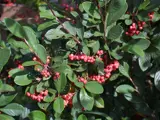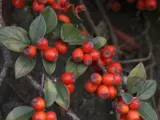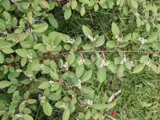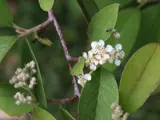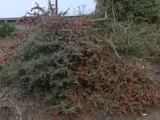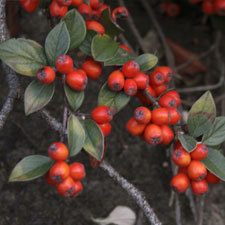 Cotoneaster
Cotoneaster
Common name: Cotoneaster
Botanical name: Cotoneaster glaucophyllus
Management programme: Sustained control - Rule 5a applies
Originates from China and the Himalayas. Was introduced to New Zealand as an ornamental garden plant and was naturalised in 1982.
Why is it a pest?
- Produces large amounts of viable seed, matures quickly, is long lived, and forms dense often pure stands outcompeting native species in a wide range of habitats.
- Competes directly with native shrubs and matures quickly.
- Tolerates grazing, damp and drought and a range of soils
Where is it found?
Cotoneaster is found scattered throughout the Bay of Plenty.
Found in scrub, wasteland, roadsides, stream sides, cemeteries, plantation, and forest margins. Birds distribute seed widely.
What does it look like?
- Spreading evergreen shrub or tree, 2-5m tall.
- Recognisable by its masses of shining red or orange berries.
- Young stems covered in downy hairs, but becoming hairless and dark reddish-purple when mature.
- Often covered in sooty mould.
- Pale blue-green leaves when young.
- Clusters of 15-60 small white flowers appear from October to January, followed by scarlet or orange berries from February to August.
What are the rules?
Sustained control
Sustained Control pests are well established in the region and preventing the spread is no longer a realistic objective. Management focuses on reducing general impacts of the pest. Landowners/occupiers are responsible for the control of these pest species on their land. Council may enforce control.
Under rule 5a of the RPMP landowners/occupiers must destroy this pest if required by a written direction from an authorised person unless a property specific pest management agreement has been agreed and signed between the occupier and the Council.
Criteria to meet Rule 5A include when the species is being actively managed by council, other agency and or community group, on an adjacent property. See the Regional Pest Management Plan 2020-2030 rules for Sustained control pests for more information.
How do you get rid of it?
Recommended:
- Dig out small plants.
- Stump treat larger plants year around with herbicide. Treat ends of cut branches if they are left on site.
- Frilling (big stems only) in summer/autumn with herbicide.
Stumps often resprout even after treatment. Follow up treatment will likely be required.
CAUTION: When using any herbicide or pesticide, PLEASE READ THE LABEL THOROUGHLY to ensure that all instructions and directions for the purchase, use and storage of the product, are followed and adhered to.
Read more on pest control advice, information and regulations.
Images

